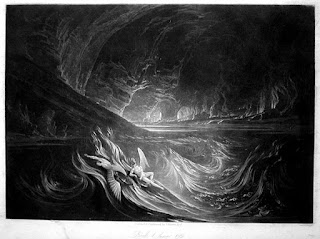It is so hard for me to get rid of things that remind me of people and places. I have all these letters and postcards...and socks.
I'm reading about how memory is closely tied to “
material mnemonics” (Hodder 2011: 155, 2012: 17). Proust’s madeleine, from his novel
In Search of Lost Time, is a popular example of the way material things evoke lost time and synesthesia/cross-sensory perception. When Proust sees the madeleine, nothing happens, but when he tastes the moist cake a whole complex of lost memories spring into his consciousness; suddenly he remembers Sunday mornings in Combray, and eating madeleines with his aunt (Hodder 2012: 137). Not the sight, but the taste of the cake brought him back. This crossing of perceptions is what, according to William Irwin Thompson, causes a delay-space in perception where the ego or self-sense arises (1998: 39). Thompson also points out that the madeleine, named after the Magdalene, is a symbol of the feminine, whether because of its labial shape, or because of its interior pink color. This is appropriate because the shell-shaped cake took Proust back not only to a female figure, but to the foundations of consciousness.
Origin of the World by Courbet. Within this experience Proust also saw what neuroscience would only recently discover: that memories evoked by olfactory cues are the most sentimental and carnal because smell and taste are the only senses that connect directly to the hippocampus, the center of the brain’s long-term memory
(Lehrer: 80). Smell and taste trigger "an archeological excavation of consciousness," to recover this primary connection to the feminine and ultimately, to origin. Thompson even argues smell and taste are archaic senses that can take us back to the mysteries of
hominization, to "the shift from estrus to menses in the new pheromonal environment that surround the birth of the human species itself--the evolutionary reorchestration of the sensorium in the shift from olfaction in the leaf-darkened forest of the primates to sight in the open and sun-drenched savanna of the hominids (1998: 43)." The other senses (sight, touch, hearing) are much less efficient in conjuring up our past (Lehrer: 80). Hodder takes this idea into the excavated site of Catalhoyuk, where 9000 year old balls of clay were found with children's teeth marks in them. He insists that the taste of the clay, like the madeleine, must have linked a neolithic person to a particular site of memories (2011: 156). It makes sense also that during "The Age of Clay," when we depended on clay for everything, we would begin telling stories of how humans came from clay. Now most every major religious tradition has a version of humans coming from dirt. In a sense, they got it right! We all have a materiel, mineral body.
Genisis 2:7 also eludes to anna-panna or breathing meditation: bring attention to your
nostrils and find your origin.
I can still remember trying to pack up my Japanese apartment two years ago and being attached to so many things, mostly gifts I had acquired over the course of five years inside one of the most generous cultures on earth. There was so much, and I had to throw things away. Collecting and surrounding myself with objects meant collecting and surrounding myself with life-experiences, because I could reflect on them, “introject” them. The theory of Introjection, or the ability for the things to magically pierce through the psychic envelope and contribute to subjectivity and the feeling of “being-in-the-world”, attracts a serious look at the material things we keep around (Wernier and the WWI daggers). While packing up, I found a box I had completely forgotten about, filled with important stuff during a house cleaning two or three years earlier. I could have, in theory, thrown the box away and have had no memory of the things. But I opened it and found memories in the box.
I had been a practicing Buddhist for ten years. Giving up things was a part of my religion. And I could see Maude sitting next to Harold (1971), receiving the tiny gift from him, throwing it into the sea, and then preemptively answering, “So I’ll always know where it is!” But I just could not give up those memories/identity markers/things, and paid the hundred dollars to ship the box home. It sits in the basement, in the dark, that portable Christmas, that portable Japan.
























